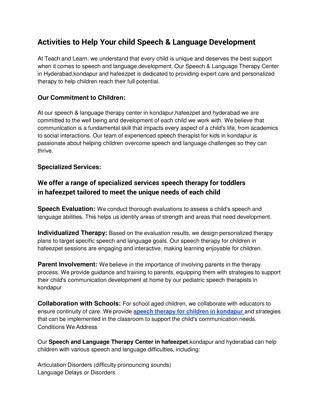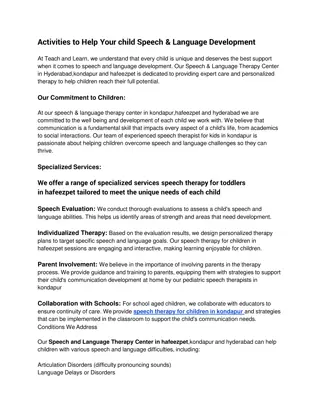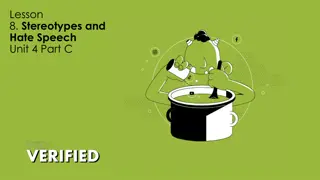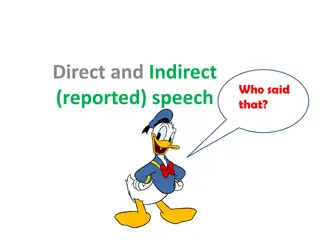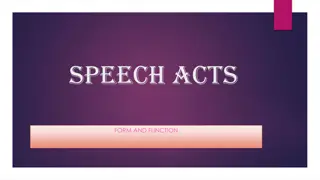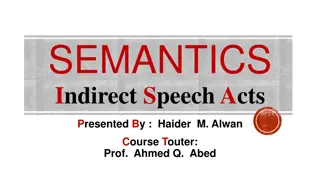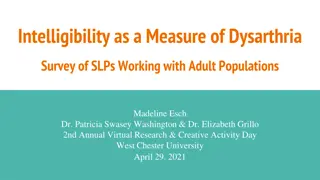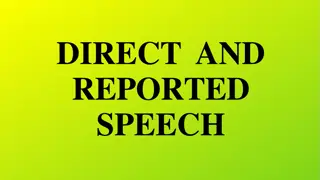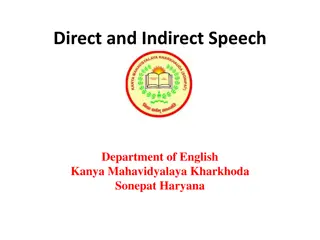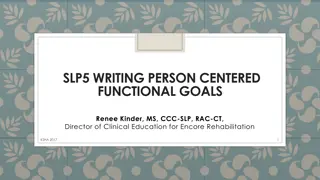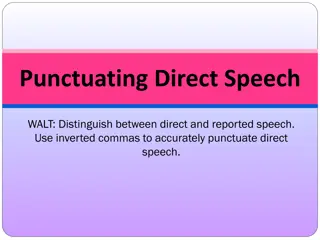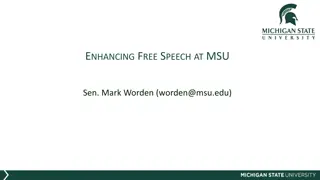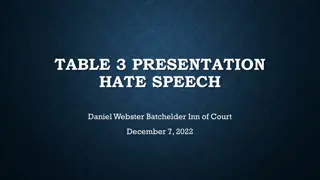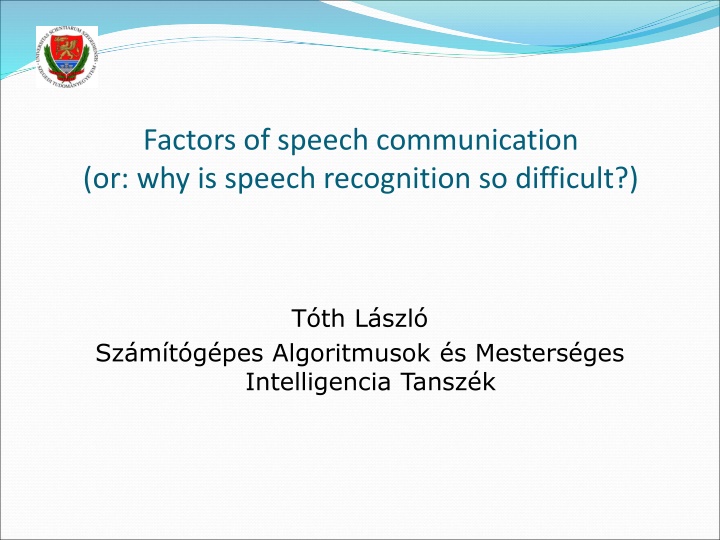
Factors of Speech Communication and Challenges in Speech Recognition
Understand the complexities of speech communication as speakers encode thoughts into speech and receivers decode them, influenced by various factors like feedback, environment, and context. Explore the building blocks of speech: phones, phonemes, and allophones, crucial for understanding language differences. Discover how phonetic transcription with tools like International Phonetic Alphabet (IPA) and SAMPA helps in analyzing speech sounds. Learn about the differences between phones and phonemes across languages like English and Hungarian, shaping speech recognition technologies.
Download Presentation

Please find below an Image/Link to download the presentation.
The content on the website is provided AS IS for your information and personal use only. It may not be sold, licensed, or shared on other websites without obtaining consent from the author. If you encounter any issues during the download, it is possible that the publisher has removed the file from their server.
You are allowed to download the files provided on this website for personal or commercial use, subject to the condition that they are used lawfully. All files are the property of their respective owners.
The content on the website is provided AS IS for your information and personal use only. It may not be sold, licensed, or shared on other websites without obtaining consent from the author.
E N D
Presentation Transcript
Factors of speech communication (or: why is speech recognition so difficult?) T th L szl Sz m t g pes Algoritmusok s Mesters ges Intelligencia Tansz k
Speech communication Speech = code: The speaker transforms his thoughts into speech: coding The receiver transforms the speech back into thoughs: decoding The communication is transmitted through a noisy channel Besides the actual message, both parties continuously receive feedback About the other (eg. if we see him/her: face, gesticulation) About the environment, eg. the channel (we hear the backgorund noise) About the context (eg. situation)
The building blocks of speech Speech sound or phone: the smallest speech segment that can be pronounced any distinct speech sound, regardless of whether the exact sound is critical to the meanings of words Theoretically it is language-independent phoneme: hte smallest unit that can make two word different. a phoneme is a speech sound that, in a given language, if it were swapped with another phoneme, would change the meaning of the word. Language-dependent, because certain differences matter in certain languages, while not in others So, if two speech segments sound different , then they are different phones If there are two words (in the given language) that differ only in that given phone, then the phone is also a phoneme at the same time allophones: the two phones sound different, but this difference in not important (forms no different words ) in the given language
Phones and phonemes t and d: these are phonemes in English, because: kit-kid In Hungarian, some people on the countryside still use the closed phone, but it makes no difference in current, official Hungarian, so it is an allophone: leesett-l esett pun and spun in English: the p (aspirated and non-aspirated) are allophones Remark: many untrained people don t hear the difference of allophones, because this is not required for language understanding Summary: the phone set of all human languages is universal (assuming that we are able to hear the differences ) However, the phoneme set of each language might be different! Phonetical transcription of speech: International Phonetic Alphabet, IPA Computerized version: SAMPA (and X-SAMPA) Developers of speech recognition systems in many cases use their own annotation system, and mix the notion of phone and phoneme R. Moore: On the Use/Misuse of the Term Phoneme , Interspeech 2019.
IPA and SAMPA Example: Hungarian vowels; for the full table see the Internet
Phonetic transcription For speech recognition, we will need to convert from ortographic transcript to phonetic transcript Is that difficult? It depends very much on the language: English: very difficult, lot of irregularities, huge differences between the written and the spoken form, this is why the dictionaries contain the spoken form (in IPA code!) French: the written and the spoken form is quite different, but the conversion is regular Hungarian, German: the written and the spoken form is quite similar, but not totally Serb: write what you say and read what you wrote Hungarian: the conversion can be done almost perfectly by rules The are mostly assimilation rules for groups of consonants Problematis cases (these require morphological analysis): Double letter or word boundary?, eg.: p cs Assimilation between stem and tag, eg: l tja vs. tj r Silence between words: more a stilistical problem ( l t j nos? - l tj nos? l tty nos? ) Hungarian Pronunciation Dictionary Web ???
Phones The main types of phones: vowels (and diphtongs), closures, fricatives, affricates, nasals, other We will see examples in the practice What is the difference between the phones? How can our ear differentiate them? How can we analyse and recognize them using computers? We will have a great visualization tool, the spectrogram (speech image) It will turn out that our ear also performs a similar spectro-temporal analysis The phones are coded in the signal by so-called acoustic cues vowels: formants; closures: place of energy burst; etc. Experts are able to read the spectrograms reasonably well However, the same phone may have different looks, decoding is surprisingly difficult We will apply machine learning: we will find the rules of the cue phone mapping automatically, based on huge amounts of training examples Machine learning seeks to operate with the least possible data-specific (in this case, speech specific) knowledge This contradicts the general goal of science, that is, gaining understanding
Why is speech recognition difficult Naive approach: let s cut the speech signal into segments, and then try to identify those segments ( segmentation and labeling ) Segmentation and labeling are both very difficult The boundaries are not clear, and the same phone can look very different The inherent source of variance: coarticulation Our articulatory organs change their positions continuously, so the neighboring phones influence the pronunciation of the actual phone The outer source variance: besides the message, the speech signal codes many other things as well Acoustic variability: background noise, distortion Between-speaker variance: pitch, size of head, talking speed, accent, dialect,.. Within-speaker variance: mental and physical state (emotional load, age, illnesses, ) If we want to extract only the message, then the above factors are noises for us
Levels of Speech Communication So far we focused on the phones and their coding However, in a normal communication situation the message should make sense at higher levels, which levels hierarchically build on each other: The speech signal codes phones (acoustic phonetics) The speech phones correspond to phonemes, which should fit the code system of the actual language (phonology) The phonemes should form words (lexicon, morphology) The words should form sentences (syntax) The sentences should have a meaning (semantics) The speaker wants to express something in the actual situation (pragmatics) If we took care only of the lowest level, then the operation of the speech recognizer would be similar to transcribing nonsense speech (or speech in some foreign language that sound similar to our own language) In human speech understanding the higher levels play a very important role So a speech recognition systems also needs a language model (syntactic model, semantic model, dialogue model) besides the acoustic model
Why is speech recognition difficult 2 The same piece of information can be present at many levels at the same time This redundancy is very helpful for both human and machine speech recognition However, in a normal talking situation we try to reduce this redundancy We are trying to speak with the least effort With put only the minimum necessary information into our speech, and the place of this information may constantly shift between the levels How do we know what is the minimum necessary ? We continuously check the partner and the environment (does he understand?) We continuously get feedback from the partner ( please repeat it slower/louder ) No feedback: we must speak with larger redundancy, decoding is easier In such situations speech recognition is close in accuracy to humans, eg. broadcast news In recognizing conversational, spontaneous, noisy speech the computer is much worse yet
Examples for the interaction of the levels, and for feedback What was that? situation and context helps understand such sentences We inform our passengers that the train arriving from xxxx will be xxxx minutes late Etimology of words with alien origin: szamosztrej sz mszer j, durchdefekt durrdefekt Funny example of how language expectations can influence what we hear: https://languagelog.ldc.upenn.edu/nll/?p=41249 Lombard effect: in noisy environments we use a more tiresome, but more efficient (understandable) pronunciation Our brain fuses the information not only from the different level s and the feedback, but sometimes also from other modalities (eg. vision)
McGurk effect What we see influences what we hear example: https://www.iflscience.com/brain/what-the-hell-is-going-on-in- this-tiktok-audio-illusion/ More scientific explanation: https://www.youtube.com/watch?&v=G- lN8vWm3m0
Factors that influence the difficulty of automatic speech recognition Quality of the acoustic environment Is there any background noise and what kind (stable of changing) Is there any channel distortion (eg. telephone, far-field microphone) What is the speaking style? Isolated commands only, or continuous speech Read-planned-spontaneous? One speaker or many? If the latter, is speaker adaptation possible? How much constrained are the sentences linguistically? Size of vocabulary? (small: max. 1-2 thousand words; mid: 5-10 thousand; large: >100 thousand) Linguistical constraints? Is the text domain-specific?


![Prevention and Combating of Hate Crimes and Hate Speech Bill [B.9B.2018]](/thumb/60513/prevention-and-combating-of-hate-crimes-and-hate-speech-bill-b-9b-2018.jpg)

